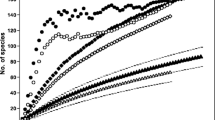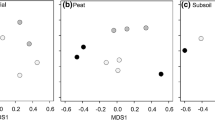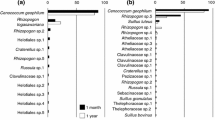Abstract
We investigated ectomycorrhizal (EM) fungi in forest stands containing both early successional Douglas-fir and late successional western hemlock at two points in the typical stand development by identifying EM fungi from roots of Douglas-fir and western hemlock in mixed stands. In an early seral stage forest, EM roots of western hemlock seedlings and intermingling 40-year-old Douglas-fir were sampled. In a late seral stage forest, EM roots of trees of both species were sampled in a 400-year-old stand. We use molecular approaches to identify the symbionts from field samples in this descriptive study. In the early seral stage study, >95% of the western hemlock root tips by biomass were colonized by fungi also colonizing Douglas-fir roots. This result supports the prediction that western hemlock can associate with fungi in Douglas-fir EM networks. In the same study, fungi specific to Douglas-fir colonized 14% of its EM root tips. In the late seral stage study, 14% of the western hemlock root tips were colonized by fungi also observed in association with Douglas-fir, a result strongly influenced by sampling issues and likely represents a conservative estimate of multiple host fungi in this old growth setting. Fungi specific to Douglas-fir colonized 25% of its root tip biomass in the old growth study, in tight coralloid clusters within five of the 24 soil samples. The trends revealed in this study corroborate earlier studies suggesting a predominance of multiple host fungi in mixed communities of EM plants. The role of host-specific fungi in these stands remains unclear.




Similar content being viewed by others
References
Agerer R (1994) Characterization of ectomycorrhizae. In: Norris JR, Read DJ, Varma AK (eds) Techniques for the study of mycorrhiza. Methods in microbiology, vol 24. Academic Press, London, pp 25–73
Agerer R (2001) Exploration types of ectomycorrhizae: a proposal to classify ectomycorrhizal mycelial systems according to their patterns of differentiation and putative ecological importance. Mycorrhiza 11:107–114
Allen EB (1984) VA mycorrhizae and colonizing annuals: implications for growth, competition and sucession. In: Williams SE, Allen MF (eds) VA mycorrhizae and reclamation of arid and semiarid lands. Science report no. SA1261. University of Wyoming Agricultural Experiment Station, Laramie, Wyo.
Anderson IC, Chambers SM, Cairney JWG (1998) Use of molecular methods to estimate the size and distribution of mycelial individuals of the ectomycorrhizal basidiomycete Pisolithus tinctorius. Mycol Res 102:295–300
Baar J, Ozinga WA, Kuyper TW (1994) Spatial distribution of Laccaria bicolor genets reflected by sporocarps after removal of litter and humus layers in a Pinus sylvestris forest. Mycol Res 98:726–728
Bergemann SE, Miller SL (2002) Size, distribution, and persistence of genets in local populations of the late-stage ectomycorrhizal basidiomycete Russula brevipes. New Phytol 156:313–320
Bever JD, Pringle A, Schultz PA (2002) Dynamics within the plant—arbuscular mycorrhizal fungal mutualism: testing the nature of community feedback. In: Van der Heidjen MGA, Sanders I (eds) Mycorrhizal Ecology. (Ecological studies vol 157) Springer, Berlin Heidelberg New York, pp 267–292
Bonello P, Bruns TD, Gardes M (1998) Genetic structure of a natural population of the ectomycorrhizal fungus Suillus pungens. New Phytol 138:533–542
Booth MG (2004) Mycorrhizal networks mediate overstorey-understorey competition in a temperate forest. Ecol Lett 7:538–546
Brown RP, Parsons RB (1973) Soils of the reference stands—Oregon IBP. US/IBP conifer forest biome internal report no. 128. University of Washington, Seattle, Wash.
Bruns TD (1995) Thoughts of the processes that maintain local species diversity of ectomycorrhizal fungi. Plant Soil 170:63–73
Bruns TD, Szaro TM, Gardes M, Cullings KW, Pan JJ, Taylor DL, Horton TR, Kretzer A, Garbelotto M, Li Y (1998) A sequence database for the identification of ectomycorrhizal basidiomycetes by phylogenetic analysis. Mol Ecol 7:257–272
Bruns TD, Bidartondo MI, Taylor DL (2002) Host specificity in ectomycorrhizal communities: What do the exceptions tell us? Integr Comp Biol 42:352–359
Christy EJ, Sollins P, Trappe JM (1982) First-year survival of Tsuga heterophylla without mycorrhizae and subsequent ectomycorrhizal development on decaying logs and mineral soil. Can J Bot 60:1601–1605
Connell JH, Slatyer RO (1977) Mechanisms of succession in natural communities and their role in community stability and organization. Am Nat 111:1119–1144
Cullings KW (1992) Design and testing of a plant-specific PCR primer for ecological and evolutionary studies. Mol Ecol 1:233–240
Cullings KW, Vogler DR, Parker VT, Finley SK (2000) Ectomycorrhizal specificity patterns in a mixed Pinus contorta, and Picea engelmannii forest in Yellowstone National Park. Appl Environ Micro 66:4988–4991
Dahlberg A, Stenlid J (1994) Size distribution and biomass of genets in populations of Suillus bovinus (L.:Fr.) Rousell revealed by somatic incompatibility. New Phytol 128:225–234
De La Bastide PY, Kropp BR, Piche Y (1994) Spatial distribution and temporal persistence of discrete genotypes of the ectomycorrhizal fungus Laccaria bicolor (Maire) Orton. New Phytol 127:547–556
Dickie IA, Koide RT, Steiner KC (2002) Influences of established trees on mycorrhizas, nutrition, and growth of Quercus rubra seedlings. Ecol Monogr 72:505–521
Dickie IA, Guza RC, Kazewski SE, Reich PB (2004) Shared ectomycorrhizal fungi between a herbaceous perennial (Helinathemum bicknellii) and oak (Quercus). New Phytol 164:375–382
Dunham SM, Kretzer A, Pfrender MW (2003) Characterization of Pacific golden chanterelle (Cantharellus formosus) genet size using co-dominant microsatellite markers. Mol Ecol 12:1607–1618
Durall D, Jones MD, Wright EF, Kroeger P, Coates KD (1999) Species richness of ectomycorrhizal fungi in cutblocks of different sizes in the Interior Cedar-Hemlock forests of northwestern British Columbia: sporocarps and ectomycorrhizae. Can J For Res 29:1322–1332
Franklin JF (1988) Pacific Northwest Forests. In: Barbour MG, Billings WD (eds) North American terrestrial vegetation. Cambridge University Press, London, pp 103–130
Franklin JF, Cromack K, Denison W, Maser C, Sedell J, Swanson F, Juday G (1981) USDA Forest Service general technical report PNW-118. USDA Forest Service Pacific Northwest Forest and Range Experiment Station, Portland, Oreg.
Franklin JF, Dyrness CT (1973) Natural vegetation of Oregon and Washington. USDA Forest Service general technical report PNW-8. USDA Forest Service Pacific Northwest Forest and Range Experiment Station, Portland, Oreg., pp 53–109
Gardes M, Bruns TD (1993) ITS primers with enhanced specificity for basidiomycetes—application to the identification of mycorrhizae and rusts. Mol Ecol 2:113–118
Gardes M, Bruns TD (1996) ITS-RFLP matching for identification of fungi. Meth Mol Biol 50:177–186
Gyrta H, Debaud J-C, Effosse A, Gay G, Marmeisse R (1997) Finescale structure of populations of the ectomycorrhizal fungus Hebeloma cylindrosporum in coastal sand dune forest ecosystems. Mol Ecol 6:353–364
Hagerman SM, Sakakibara SM, Durall DM (2001) The potential for woody understory plants to provide refuge for ectomycorrhizal inoculum at an interior Douglas-fir forest after clear-cut logging. Can J For Res 31:711–721
Harley JL, Smith SE (1983) Mycorrhizal symbiosis. Academic Press, London, pp 357–386
Harvey AE, Larsen MJ, Jurgensen MF (1976) Distribution of ectomycorrhizae in a mature Douglas-fir/larch forest soil in Western Montana. For Sci 22:393–398
Horton TR (2002) Molecular approaches to ectomycorrhizal diversity studies: variation in ITS at a local scale. Plant Soil 244:29–39
Horton TR, Bruns TD (1998) Multiple host fungi are the most frequent and abundant ectomycorrhizal types in a mixed stand of Douglas-fir (Pseudotsuga menziesii) and bishop pine (Pinus muricata). New Phytol 139:331–339
Horton TR, Bruns TD (2001) The molecular revolution in ectomycorrhizal ecology: Peeking into the black-box. Mol Ecol 10:1855–1871
Horton TR, Bruns TD, Parker VT (1999) Ectomycorrhizal fungi associated with Arctostaphylos contribute to Pseudotsuga menziesii establishment. Can J Bot 77:93–102
Johnson NC, Smith FA (1997) Functioning of mycorrhizal associations along the mutualism-parastism continuum. New Phytol 135:575–585
Kårén O, Hogberg N, Dahlberg A (1997) Inter- and intraspecific variation in the ITS region of rDNA of ectomycorrhizal fungi in Fennoscandia as detected by endonuclease analysis. New Phytol 136:313–325
Kennedy PG, Izzo AD, Brunst TD (2003) There is high potential for the formation of common mycorrhizal networks between understorey and canopy trees in a mixed evergreen forest. J Ecol 91:1071–1080
Kranabetter JM, Wylie T (1998) Ectomycorrhizal community structure across forest openings on naturally regenerated western hemlock seedlings. Can J Bot 76:189–196
Kretzer AM, Dunham S, Molina R, Spatafora JW (2004) Microsatellite markers reveal the below ground distribution of genets in two species of Rhizopogon forming tuberculate ectomycorrhizas on Douglas-fir. New Phytol 161:313–320
Kretzer AM, Li Y, Szaro T, Bruns TD (1996) Internal transcribed spacer sequences from 38 recognized species of Suillus sensu lato: phylogenetic and taxonomic implications. Mycologia 88:776–785
Kretzer AM, Luoma DL, Molina R, Spatafora JW (2003) Taxonomy of the Rhizopogon vinicolor species complex based on analysis of ITS sequences and microsatellite loci. Mycologia 95:479–486
Kropp BR, Trappe JM (1982) Ectomycorrhizal fungi of Tsuga heterophylla. Mycologia 74:479–488
Lilleskov EA, Fahey TJ, Horton TR, Lovett GM (2002) Belowground ectomyocrrhizal fungal community change over a nitrogen deposition gradient in Alaska. Ecology 83:104–115
Massicotte HB, Molina R, Luoma DL, Smith JE (1994) Biology of the ectomycorrhizal genus, Rhizopogon. II. Patterns of host-fungus specificity following spore inoculation of diverse hosts grown in monoculture and dual culture. New Phytol 126:677–690
Massicotte HB, Molina R, Tackaberry LE, Smith JE, Amaranthus MP (1999) Diversity and host specificity of ectomycorrhizal fungi retrieved from three adjacent forest sites by five host species. Can J Bot 77:1053–1076
Molina R, Trappe JM (1982) Lack of mycorrhizal specificity by the ericaceous hosts Arbutus menziesii and Arctostaphylos uva-ursi. New Phytol 90:495–509
Molina R, Massicotte H, Trappe JM (1992) Specificity phenomena in mycorrhizal symbiosis: community-ecological consequences and practical implications. In: Allen MF (ed) Mycorrhizal functioning: an integrated plant-fungal process. Chapman and Hall, London, pp 357–423
Molina R, Trappe JM (1994) Biology of the ectomycorrhizal genus, Rhizopogon I. Host associations, host-specificity and pure culture syntheses. New Phytol 126:652–675
Newman EI (1988) Mycorrhizal links between plants: their functioning and ecological significance. Adv Ecol Res 18:243–270
O’Dell TE, Ammirati JF Schreiner EG (1999) Species richness and abundance of ectomycorrhizal basidiomycete sporocarps on a moisture gradient in the Tsuga heterophylla zone. Can J Bot 77:1699–1711
Oliver CD, Larson BC (1990) Forest stand dynamics. McGraw-Hill, New York
Onguene NA, Kuyper TW (2002) Importance of the ectomycorrhizal network for seedling survival and ectomycorrhiza formation in rain forests of south Cameron. Mycorrhiza 12:13–17
Perry DA, Amaranthus MP, Borchers JG, Borchers SL, Brainerd RE (1989a) Bootstrapping in ecosystems. Bioscience 39:230–237
Perry DA, Margolis H, Choquette C, Molina R, Trappe JM (1989b) Ectomycorrhizal mediation of competition between coniferous tree species. New Phytol 112:501–511
Pickett STA, Collins SL, Armesto JJ (1987) A hierarchical consideration of causes and mechanisms of succession. Vegetatio 69:109–114
Redecker D, Szaro TM, Bowman RJ, Bruns TD (2001) Small genets of Lactarius xanthogalactus, Russula cremoricolor and Amanita francheti in late stage ectomycorrhizal successions. Mol Ecol 10:1025–1034
Rogers SO, Yan ZH, Shinohara M, LoBuglio F, Wang CJK (1993) Messenger RNA intron in the nuclear 18s ribosomal RNA gene of deuteromycetes. Curr Gen 23:338–342
Sawyer NA, Chambers SM, Cairney JWG (1999) Molecular investigation of genet distribution and genetic variation of Cortinarius rotundisporus in eastern Australian sclerophyll forests. New Phytol 142:561–568
Schrader B (1998) Structural development of late successional forests in the central Oregon Coast Range: abundance, dispersal, and growth of western hemlock (Tsuga heterophylla) regeneration. PhD thesis. Department of Forest Science, Oregon State University, Corvallis, Oreg.
Selosse M-A, Jacquot D, Bouchard D, Martin F, Le Tacon F (1998a) Temporal persistence and spatial distribution of an American inoculant strain of the ectomycorrhizal basidiomycete Laccaria bicolor in a French forest plantation. Mol Ecol 7:561–573
Selosse M-A, Martin F, Le Tacon F (1998b) Survival of an introduced ectomycorrhizal Laccaria bicolor strain in a European forest plantation monitored by mitochondrial ribosomal DNA analysis. New Phytol 140:753–761
Simard SW, Perry DA, Jones MD, Myrold DD, Durall DM, Molina R (1997) Net transfer of carbon between ectomycorrhizal tree species in the field. Nature 338:579–582
Smith JE, Molina R, Perry DA (1995) Occurrence of ectomycorrhizas on ericaceous and coniferous seedlings grown in soils from the Oregon Coast Range. New Phytol 129:73–81
Smith SE, Read DJ (1997) Mycorrhizal symbiosis. Academic Press, New York
Smith JE, Molina R, Huso MMP, Luoma DL, Mckay D, Castellano MA, Lebel T, Valachovic Y (2002) Species richness, abundance, and compostion of hypogeous and epigeous ectomycorrhizal fungal sporocarps in young, rotation-age, and old-growth stands of Douglas-fir (Pseudotsuga menziesii) in the Cascade Range of Oregon, USA. Can J Bot 80:186–204
Spiese TA (1991) Plant species diversity and occurrence in young, mature, and old-growth Douglas-fir stands in western Oregon and Washington. In: Ruggiero LF, Aubry KB, Carey AB, Huff MH (eds) Wildlife and vegetation of unmanaged Douglas-fir forests. General Technical Report PNW-GTR-285, USDA Forest Service Pacific Northwest Research Station, Porland, OR, pp 111–121
Swofford DL (2002) PAUP*. Phylogenetic analysis using parsimony (*and other methods), version 4. Sinauer, Sunderland, Mass.
Taylor AFS (2002) Fungal diversity in ectomycorrhizal communities: sampling effort and species detection. Plant Soil 244:19–28
Trappe JM, Fogel RD (1977) Ecosystematic functions of mycorrhizae. Colo State Univ Range Sci Dept Sci Ser 26:205–214
van der Heijden MGA, Klironomos JN, Ursic M, Moutoglis P, Streitwolf-Engel R, Boller T, Wiemken A, Sanders IR (1998) Mycorrhizal fungal diversity determines plant biodiversity, ecosystem variability and productivity. Nature 396:69–72
Vanderplank JE (1978) Genetic and molecular basis of plant pathogenesis. Springer, Berlin Heidelberg New York
White TJ, Bruns TD, Lee SB, Taylor JW (1990) In: Innis MA, Gelfand DH, Sninsky JJ, White TJ (eds) Amplification and direct sequencing of fungal ribosomal RNA genes for phylogenetics. PCR protocols—a guide to methods and applications. Academic Press, New York, pp 315–322
Zhou Z, Makoto M, Hogetsu T (1999) Analysis of genetic structure of a Suillus grevillei population in a Larix kaempferi stand by polymorphism of inter-simple sequence repeat (ISSR). New Phytol 144:55–63
Zhou Z, Miwa M, Matsuda Y, Hogetsu T (2001) Spatial distribution of the subterranean mycelia and ectomycorrhizae of Suillus grevillei genets. J Plant Res 114:179–185
Acknowledgements
We thank Jane Smith for generously allowing us to collect belowground samples from one of her permanent sporocarp plots and to sample sporocarp voucher collections for DNA extraction and subsequent molecular analysis; Doni McKay for time and effort in supporting the laboratory; Joyce Eberhart for advice on morphological typing of EM roots; Dan Luoma for helpful advice leading to the identification of Suillus punctatipes; Annette Kretzer for access to her aligned sequence database for the genus Suillus; Steve Miller for help identifying Russula spp. This project was funded in part by support from the US Forest Service and NRI Competitive Grants Program/USDA award 99-35107-7843.
Author information
Authors and Affiliations
Corresponding author
Rights and permissions
About this article
Cite this article
Horton, T.R., Molina, R. & Hood, K. Douglas-fir ectomycorrhizae in 40- and 400-year-old stands: mycobiont availability to late successional western hemlock. Mycorrhiza 15, 393–403 (2005). https://doi.org/10.1007/s00572-004-0339-9
Received:
Accepted:
Published:
Issue Date:
DOI: https://doi.org/10.1007/s00572-004-0339-9




